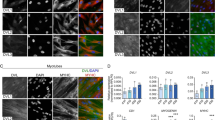Abstract
We have investigated the mechanism by which expression of the v-myc oncogene interferes with the competence of primary quail myoblasts to undergo terminal differentiation. Previous studies have established that quail myoblasts transformed by myc oncogenes are severely impaired in the accumulation of mRNAs encoding the myogenic transcription factors Myf-5, MyoD and Myogenin. However, the mechanism responsible for such a repression remains largely unknown. Here we present evidence that v-Myc selectively interferes with quail myoD expression at the transcriptional level. Cis-regulatory elements involved in the auto-activation of qmyoD are specifically targeted in this unique example of transrepression by v-Myc, without the apparent participation of Myc-specific E-boxes or InR sequences. Transiently expressed v-Myc efficiently interfered with MyoD-dependent transactivation of the qmyoD regulatory elements, while the myogenin promoter was unaffected. Finally, we show that forced expression of MyoD in v-myc-transformed quail myoblasts restored myogenin expression and promoted extensive terminal differentiation. These data suggest that transcriptional repression of qmyoD is a major and rate-limiting step in the molecular pathway by which v-Myc severely inhibits terminal differentiation in myogenic cells.
This is a preview of subscription content, access via your institution
Access options
Subscribe to this journal
Receive 50 print issues and online access
$259.00 per year
only $5.18 per issue
Buy this article
- Purchase on Springer Link
- Instant access to full article PDF
Prices may be subject to local taxes which are calculated during checkout



Similar content being viewed by others
References
Alemà S, Tatò F . 1994 Sem. Cancer Biol. 5: 147–156
Amati B, Frank SR, Donjerkovic D, Taubert S . 2001 Bioch. Bioph. Acta 1471: M135–M145
Birchmayer C, Gherardi E . 1998 Trends Cell Biol. 8: 404–410
Crescenzi M, Crouch DH, Tatò F . 1994 J. Cell Biol. 125: 1137–1145
Crouch DH, Fisher F, Clark W, Jayaraman PS, Goding CR, Gillespie DAF . 1993 Oncogene 8: 1849–1855
Falcone G, Tatò F, Alemà S . 1985 Proc. Natl. Acad. Sci. USA 82: 426–430
Gartel AL, Ye X, Goufman E, Shianov P, Hay N, Najmabadi F, Tyner L . 2001 Proc. Natl. Acad. Sci. USA 98: 4510–4515
Grandori C, Cowley SM, James LP, Eisenman RN . 2000 Annu. Rev. Cell Dev. Biol. 16: 653–699
Kretzner L, Blackwood EM, Eisenman RN . 1992 Curr. Top. Microbiol. Immunol. 182: 435–443
La Rocca SA, Grossi M, Falcone G, Alemà S, Tatò F . 1989 Cell 58: 123–131
La Rocca SA, Crouch DH, Gillespie DAF . 1994 Oncogene 9: 3499–3508
Lassar AB, Skapek SX, Novitch B . 1994 Curr. Opin. Cell Biol. 6: 788–794
Li L, Olson EN . 1992 Adv. Cancer Res. 58: 95–120
Maione R, Amati P . 1997 Biochim. Biophys. Acta 1332: 19–30
Malik S, Huang CF, Schmidt J . 1995 Eur. J. Biochem. 230: 88–96
Miner JH, Wold BJ . 1991 Mol. Cell. Biol. 11: 2842–2851
Molkentin JD, Olson EN . 1996 Curr. Opin. Genes Dev. 6: 453–455
Murry CE, Kay MA, Bartosek T, Hauschka SD, Schwartz SM . 1996 J. Clin. Invest. 98: 2209–2217
Pinney DF, de la Brousse FC, Faerman A, Shani M, Maruyama K, Emerson Jr CP . 1995 Dev. Biol. 170: 21–38
Pollerberg GE, Kuschel C, Zenke M . 1995 J. Neurosci. Res. 41: 427–442
Puri PL, Sartorelli V . 2000 J. Cell. Physiol. 185: 155–173
Russo S, Tatò F, Grossi M . 1997 Oncogene 14: 63–73
Tajbakhsh S, Buckingham ME . 1994 Proc. Natl. Acad. Sci. USA 91: 747–751
Zimmerman K, Yancopoulos GD, Collum RG, Smith RK, Kohl NE, Denis KA, Nau MM, Witte ON, Toran-Allerand D, Gee CE, Minna JD, Alt FW . 1986 Nature 319: 780–783
Acknowledgements
We thank S Alemà (CNR, Roma, Italy) for the adenoviral vectors, D Fischman (Cornell University, New York, USA) for the MF20 antibody, D Gillespie (CRC Beatson Laboratories, Glasgow, UK) for the 237 antibody, E Olson (UT Southwestern Medical Center, Dallas, USA) for the myogenin constructs, B Paterson (NIH, Bethesda, USA) for the anti-Myogenin antibody, G Piaggio (Istituto Regina Elena, Roma, Italy) for the M4 construct and M Zenke (MDC, Berlin, Germany) for the pmycER-ts-sea vector. This work was supported by grants from Associazione Italiana per la Ricerca sul Cancro (AIRC), MURST (Cofin 1999) and CNR/MURST (Legge 95/95).
Author information
Authors and Affiliations
Corresponding author
Rights and permissions
About this article
Cite this article
La Rocca, S., Vannucchi, S., Pompili, M. et al. Selective repression of myoD transcription by v-Myc prevents terminal differentiation of quail embryo myoblasts transformed by the MC29 strain of avian myelocytomatosis virus. Oncogene 21, 4838–4842 (2002). https://doi.org/10.1038/sj.onc.1205586
Received:
Revised:
Accepted:
Published:
Issue Date:
DOI: https://doi.org/10.1038/sj.onc.1205586



